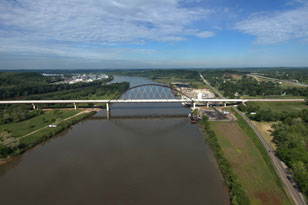 On March 30, 2005, the Division of Highways took its next step into the future with the award of a contract for the most expensive single contract it has ever undertaken, the final project to complete an expressway already 40 years in the making.
On March 30, 2005, the Division of Highways took its next step into the future with the award of a contract for the most expensive single contract it has ever undertaken, the final project to complete an expressway already 40 years in the making.
Work is already under way on the cofferdams necessary for construction of piers for the $135 million Blennerhassett Bridge, slated to carry Appalachian Corridor D (US 50) across the Ohio River from Parkersburg.
After two decades of questions about its effects, the tied-arch bridge was chosen from four design alternatives as most economical and least intrusive on the environment of historic Blennerhassett Island, a site offered by its namesake to Aaron Burr in 1805 as a rendezvous for training volunteers and gathering arms and supplies, now home to a mansion recreated to duplicate the original destroyed by the Virginia militia after the collapse of Burr’s conspiracy.
Passing over the western end of the island and crossing both the main navigational and secondary channel of the river on concrete piers about 69 feet above the river, the weathering steel bridge will total approximately 4,009 feet from abutment to abutment and provide four travel lanes with shoulders wide enough to serve traffic during emergencies or future maintenance work.
The contract awarded to Walsh Construction Company of Chicago calls for more than 14,705 tons of structural steel. A continuous girder bridge of eight spans ranging from 200 to 400 feet comprising the 2629-foot approach from the WV 892 interchange will use 16.3 million pounds of plate girder steel, with nearly 1.6 million pounds in the continuous girder bridge of three spans ranging from 140 to 179 feet comprising the 494-foot approach from Ohio Route 618. Over 11.5 million pounds of a different class of structural steel will be used for the 880-foot tied arch over the main channel.
One of the original 23 Appalachian Development Highway System routes designated in 1965, Corridor D was planned to link I-79 at Clarksburg with I-275 near Cincinnati. The first contract of West Virginia’s 82 miles, for four-lane upgrading of US 50 in Doddridge County, was completed in 1967. The last mileage between interstates 77 and 79, a segment on the Clarksburg Expressway, was completed in 1978. But routing of the ten-mile segment from I-77 to the Ohio River crossing remained undecided for over two decades until the Federal Highway Administration approved a Record of Decision in 1999 allowing design to proceed. In 2000, using federal funding obtained by Senator Byrd as far back as 1991, Highways began work to finish the final segment. Since that time, 20 contracts have been awarded, including the bridge, relocation of Parkersburg athletic fields and mitigation for wetland affected by construction.
In the joint venture with the Ohio Department of Transportation, West Virginia will pay approximately 65 percent of the cost of the bridge from accumulated amounts left in various appropriations bills, extra money provided by US Senator Robert C. Byrd and regular 80 percent-20 percent Appalachian Corridor highway financing—exhausting a major portion of a whole year’s funding on a single bridge, as it did in July 1973 for the New River Bridge.
The state long recognized for its bridges knows that such a financial commitment is an investment in the future. From the past to the future, West Virginia continues to design, innovate and build crossings that influence bridge building throughout the world.